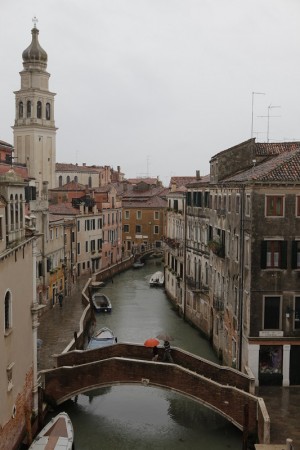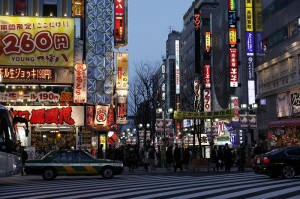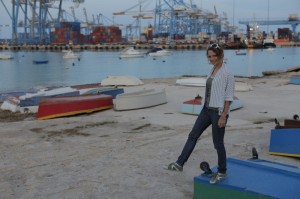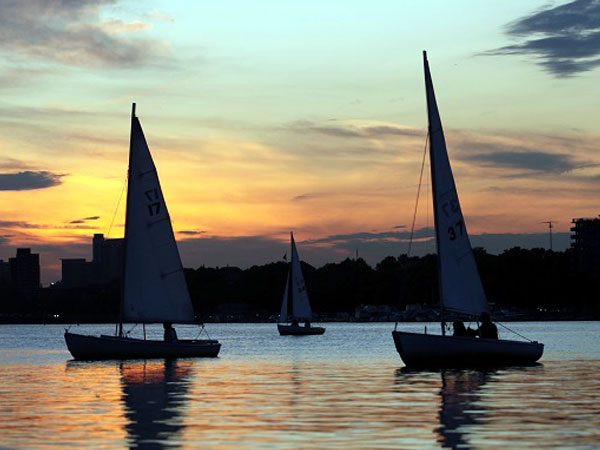TLC discovers vibrant port cities through the eyes of Heidi Hollinger
The world’s greatest cities have always been built close to water. Settled centuries ago when boat travel was the only means of communication, these ports have developed into commercial and cultural metropolises, each rich in their unique history. Premiering every Thursday at 9:00 p.m. starting July 18, TLC’s second season of WATERFRONT CITIES OF THE WORLD follows world-renowned Canadian-born photographer Heidi Hollinger, as she travels the globe to visit some of the most vibrant port cities, explore their beauty and history, and find out what makes each of them special. WATERFRONT CITIES OF THE WORLD encores every Friday at 8:00 a.m., Saturday at 12:00 p.m. and Sunday at 8:00 p.m.
There are over 500,000 port cities scattered across the globe, all hubs of commercial trade, military activity, cultural trends, and population migrations.
The second season of WATERFRONT CITIES OF THE WORLD profiles 13 different cities – Boston, Copenhagen, Hong Kong, Istanbul, Panama City, Saint Petersburg, Salvador de Bahia, Singapore, Tokyo, Valletta, Vancouver, and Venice – as seen through the lens of host and guide Hollinger. Hollinger, whose portraits of Russian leaders in the 1990s are said to have revolutionised photography there, focuses her keen eye on each of these destinations. In these bustling centres, she connects with locals, both natives and new residents alike, in order to provide an in-depth look its character and charm.
In this day and age where air travel has made it faster and easier to reach distant places, and railways traverse continents, do port cities still have a place in our modern world? Each episode looks at how each of these cities, enriched by their past of cultural exchange, continue to have a powerful impact on human civilisation. What makes these cities so unique and how has their access to the rest of the world made them so attractive?
Discover the beauty and complexity of these global port cities; where a nation met the rest of the world, where the familiar met the exotic, and where the known met the unknown.
Article continues after this advertisementHighlights from WATERFRONT CITIES OF THE WORLD include:
Article continues after this advertisementSingapore
For several years, Singapore has been neck and neck with Shanghai as the largest port in the world. Independent from Malaysia since 1965, this city-state has undergone the fastest growth in Asia.
Only 50 years ago, the archipelago of tropical forests was covered in tiny wooden houses; today, Singapore is one of the world’s most vibrant cities, host to some of today’s most ambitious architectural projects.
There has been such intense development that the city-state has run out of space. But Singapore has found a way to expand through landfill, adding more than 130 square kilometers over the last 35 years with plans to add 100 more by 2030. Explore and understand Singapore through its evolution and population – not only the Chinese, Malays, Indians and Eurasians but the foreign workers that now make up 45%.
Visit Pulau Ubin, an island left largely untouched since 1965 to see how things were not so long ago. Heidi also learns why, in a booming economy, nine out of 10 people there live in government housing projects. Despite being portrayed to the outside world as a city of rules and strict regulations, life is great in Singapore.
Venice
Known for its gondolas, sunsets and amazing light, Venice is the world’s only medieval city still standing today. How did this small city that sprung from a lagoon become the strongest empire in Europe at one point, and what inspired its founders to build a city from a swamp?
For 1,000 years, Venice was a trading capital, an economic power linked to the sea. It was the center of activity and the warehouse for tradesmen, seamen, and artisans from Greece, Germany, Armenia, Egypt, Turkey, the Dalmatae, and the Jews from around the world.
Built on wooden stilts, the city is truly amphibious, living in harmony and occasionally in confrontation with the tides; but for how long? The Aqua Alta – the yearly periods of floods – is gradually destroying Venice.

The truth is that the 21 million tourists that take over Venice each year are a bigger threat to its survival. Discover another side of Venice beyond the canals and St. Mark’s Square, the one that exists when the day tourists head back to the ships, and the city returns to the silence and comfort of a city without cars.
Panama City
On the southern tip of Central America, Panama City is quickly redefining and rebuilding itself. After years of military reign and silence, it has now become one of the world’s most popular retirement destinations.
With its increasing popularity and the economic boom it is generating, Panama City is facing an important population density crisis. The unfortunate absence of urban planning has had an impact on its evolution and the central neighbourhoods are now home to four times more people than what they were originally conceived for.
With its natural frontiers in the way, the city has nowhere to expand with the ocean to the south, the Panama Canal in the center, and the last dry tropical forest in South America on all other sides. The result is the blossoming of high rise after high rise, growing between patches of tropical wildlife.
The most impressive element of the city however is definitely the Panama Canal, with its southern access right in the heart of the city. This 77-kilometre waterway, built by the Americans between 1907 and 1914, was one of the world’s largest and most costly engineering projects. It has changed navigation and commerce in a radical way.
Under American control until 1977, the Canal is now managed and owned by Panama, and handles more than 14,000 ships a year. Heidi pays a visit to this country before the crowds rush in.
Boston
Founded in 1630 by British Puritans fleeing religious persecution, Boston was developed on a site that was used to the settlers’ advantage. Massachusetts Bay provided shelter for ships, and its peninsular geography was a natural defense. Its economy has long relied on port activities and textiles.
With economic growth and immigration, the colonial city was quickly short on space so the filling and draining of wetlands during the 19th century allowed the development of new neighbourhoods. The Back Bay neighbourhood for example is entirely built on manmade terrain.
Between 1630 and 1890, Boston’s size tripled. The city created new parks and public gardens – the Boston Common – with the help of landscape architect Frederick Law Olmsted. Two of the three hills that formed Boston at the time, the Trimountains, were shaved to fill the waters of the port.
In the mid-nineteenth century, Boston was populated by thousands of Irish families fleeing famine; by 1900, nearly half of Bostonians were of Irish origin. Today, Boston is a city of many ethnicities.
The high concentrations of higher education and research institutes explain the low average age of its population, as well as its nickname “Athens of America”. Recently, Boston underwent the largest, and most expensive (US$22 billion!), highway reconstruction project in the US The Big Dig project rerouted Interstate 93, the main artery that crossed the city, and home to the biggest traffic jams in the country, into a 5.6-kilometre tunnel under Boston.
Tokyo
Tokyo Bay is the largest agglomeration in the world and is home to more than 34 million people. Comprised of 26 cities, 23 wards, five sub-prefectures, eight villages, and several islands, it is so active that its population increases by 2.5 million people during the day, just with workers coming in from the suburbs.
Demolished by an earthquake in 1923 and again by attacks during the Second World War, it was completely rebuilt. Sixty years later, the former fishing village is now largely composed of skyscrapers, and has retained very little of its original structures.

Heidi takes a closer look at Tokyo’s transportation system, which includes the world’s busiest subway and largest train network, and examines the Japanese demand for automation from the 9,000 space underground automated bicycle parking lot to the millions of vending machines spread across the city.
Copenhagen
It is said that Copenhagen is primarily designed for its people: it’s very practical and very down to earth. In the Danish capital, everything works extremely well. In terms of energy, the city has done its homework and now ranks among the world leaders in generating clean energy and sustainable development. In the port of Copenhagen, 27 windmills adorn the landscape. But the port here isn’t an industrial mess – between the ships, the water is clean, and the docks are used by locals for casual family swimming.
In architecture, although several cities claim to be the capital of modern, Copenhagen officially takes home the prize. The visual landscape of the northern city is simply outstanding. Since the oil crisis of the 1970s, Copenhagen turned to the bicycle as an effective means of transportation and it has earned the title of international bike city with more than one bike per person.
It is estimated that 50% of trips in the city and its suburbs will be made by bicycle in 2015. To alleviate the serious congestion on bike paths, bicycle highways are being built to commute to and from the city. Traffic lights are also synchronized for a trip at a speed of 20 km/h. In Copenhagen, everything is done on a bicycle, even in the snow.
Valletta
Valletta, the capital of Malta, is undoubtedly the smallest city to be explored by the series…but it’s definitely worth the trip. Officially recognised by UNESCO as a World Heritage Site in 1980, Valletta was founded in 1565 and provided a safe haven for just about anyone.
Located in the middle of the Mediterranean Sea (93 kilometers off the coast of Sicily, 190 kilometres from Tunisia) it was a meeting point for cultures from every part of the world. The city was also the world’s first example of “modern” urban development. It was constructed in a grid stemming from the sea in order to give the inhabitants a permanent natural air conditioning.
Valletta has many surprises – a vast network of underground tunnels has now been found, showing a possible secret life under the city. Recent excavations have also shown that the city planners of the 1500s had hidden five underground fresh water reservoirs to be used in case of a siege forming part of a state-of-the-art plumbing system, complete with ancient passageways for access and maintenance.
Heidi explores its unique architecture, with its closed balconies that are a distinctive element of the cityscape, and discovers the reason why entire neighbourhoods were abandoned in the 1970’s. Also take a glimpse at the Valletta of tomorrow, and the rapid influx of British that seem to be taking over the island.
Valencia
Land of oranges, Valencia is Spain’s third city in importance after Madrid and Barcelona. It was founded in 138 BC by a Roman centurion named Decimus Junius Brutus, who named it Valentia, meaning force. Its strategic location on the Mediterranean attracted Greeks, Romans and Moors, who have taken turns at its control.
During the Roman Empire, Valencia was a supply restocking city for ships, and a major trading hub. The arrival of Islamic culture contributed to the development of crafts in ceramics, glass, paper, silk, and leather, and gave the city a network of irrigation canals for the surrounding fields. Valencia quickly became a leading agricultural center and to this day, its main economic activities are still trade and agriculture. The neighbourhoods of Valencia transcend time.

After a major flood of the Turia River in 1957, the river that crossed the city was diverted and converted into immense gardens, the Turia Gardens. Today, with its parks and long beaches, Valencia has no car congestion, just the sea and the perfect climate – 330 days of sunshine a year! Valencia is all about conviviality, where partying is an art.
Saint Petersburg
Saint Petersburg is the new Russia: it is a precious link between a large inaccessible country and the rest of the world and is now the transition between the old and new, in what remains of the Soviet Union.
Radically different from Moscow through its port and its location, its history is all about multiculturalism. It was a battlefield throughout its history, and the center of many military strategies until it lost its title of Capital of the Russian Empire in 1918.
Life quickly became too difficult, and more than two million people, mostly intellectuals, packed up and left town. The city was finally destroyed by Stalin himself in order to prevent Hitler from organizing a Christmas celebration in 1941.
In recent years, however, it has once again become a capital, albeit a social and cultural one. A visit to Saint Petersburg is a visual adventure – the extravagance of Peter the Great and Catherine II made Saint Petersburg a laboratory, a sort of reaction to what was happening elsewhere in the world.
In wanting to compete with the major architectural masterpieces of the planet, they built the city bigger and more beautiful than anything found in Europe: a palace in the image of Versailles, yet larger and more symmetrical; The Gardens of Czars, like the Boboli Gardens, only more majestic and impressive.
Istanbul
In a city that keeps growing, the question facing Istanbul is, “where do we put all the people?” Due to the high density and historical importance of its buildings, creating or renovating structures is an issue.
But the city continues to welcome an eclectic group of cultures – booming economically and socially – and is becoming one of the most dynamic cities in the world.
Located at the junction of Europe and Asia and divided by the mighty Bosphorus, Istanbul was already teeming with activity long before the discovery of America.
Even when it was known as Byzantium and Constantinople, it was already considered the hub of the world – the place where everyone wanted to be. Today, the city is expanding at full speed and its population is increasing rapidly. How can Istanbul accommodate the influx of people who are flocking to the city?
Housing is a major preoccupation of the people, as building and renovating in Istanbul is a complicated business. Every inch of the city contains traces of the past – historical remnants that cannot be destroyed. Explore Istanbul and navigate through the challenges it faces as the dynamic city continues to amaze Heidi with its cultural depth.
Salvador De Bahia
By far the most African of all the American cities, Salvador de Bahia was colonized by the Portuguese in the past. It was the first capital of Brazil and a hub of the slave trade, where many Africans earned their living working in the sugar industry.
Till this day, a large part of its population is of African descent. The Afro-Mediterranean mix at Salvador de Bahia has created a unique ‘Bahian’ culture with defining elements like capoeira, a fusion of dance and martial arts.
Surrounded by long, endless stretches of beaches, beautiful Salvador de Bahia is described by its inhabitants as the city of happiness, and it is not hard to see why.
The city of about three million inhabitants is divided in two – the port and bourgeois neighbourhoods are at the lower end, while the most important relics of colonial architecture exist in the upper city.
However, the accelerating construction of skyscrapers is threatening the survival of the old quarters. Whole sections of the ancient town are about to disappear, thus robbing Salvador de Bahia of its unique architecture. Will modernism snatch away the heritage that defines this oasis of culture?
Hong Kong
Meaning “fragrant harbour” in Chinese, Hong Kong is by far the most vertical city in the world with its astounding number of skyscrapers – over 7,000! In fact, it is easy to forget that the populous hub actually extends over 200 islands, with more than half of its territory consisting of mountainous parks.
The mountainous terrain limits urban development, and space is so scarce that nearly a quarter of the city is built on landfill. In fact, its population of seven million people actually only resides on 25 percent of its territory. Since its handover to China in 1997, Hong Kong continues to flourish and brims with a cultural richness that is not about to fade.
The city acts as a bridge between Western and mainland Chinese markets, continuing to make its presence felt as a key commercial hub in Asia. A model of efficiency, Hong Kong keeps its residents on the move with an excellent public transport system as less time in traffic means more time being productive.
The high level of mass transit usage is attributed to the system’s interconnectedness and affordability, and the city’s compact, high-density urban design. Heidi gets a better understanding of the appeal of Hong Kong, its local customs, the importance of Feng Shui, and what makes Hong Kongers different from the rest of China.
Vancouver
Nestled between the sea and mountains, Vancouver is both a city of water as well as an outdoor haven, which explains its citizens’ obsession with sports. Just 125 years ago, this city was virgin forest and Heidi finds out how such a young city managed to develop in population, size and importance in such a short time.
It is a place where everybody comes from somewhere else – about a third of the population is Chinese, and the rest is a dizzying mixture of various cultures and heritage.
However, the metropolis is getting denser by the day. Vancouver is exploring creative solutions to control the urban sprawl, resulting in the development of beautiful small houses in the alleys of the city. Housing continues to remain a hot topic in Vancouver, with citizens spending more than half of their gross income on it.
As the only metropolis in North America that does not have an expressway, will Vancouver attain its dream of becoming the greenest city in the world by 2020?
